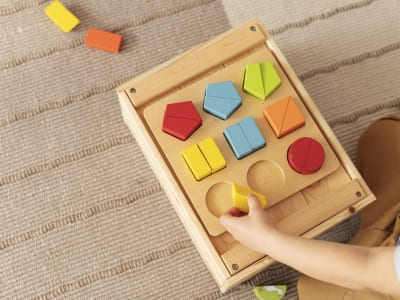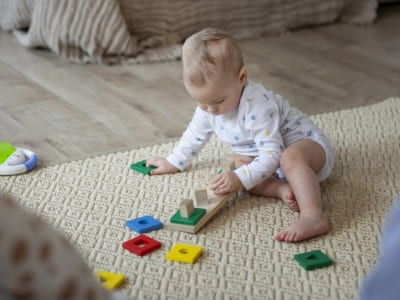Evolutionary play mats
A quality play mat will accompany your baby for several months. Look for ones with removable arches, toys suspended at different heights, and floor elements: unbreakable mirrors, crinkling surfaces, small cushions with various textures. This variety encourages movement and develops back muscles.
Soft sensory cubes
Fabric cubes with different activities on each side offer remarkable versatility. Mirrors, bells, crinkly fabrics, Velcro, pretend zippers... Each element develops a specific skill while maintaining the child's interest.
6-9 Months: Mastery of sitting and active exploration
Baby can now sit unassisted and use both hands in a coordinated manner. This is the time to introduce more complex toys that will stimulate their growing curiosity.
Adapted stacking toys
Colorful stacking rings on a rod develop two-handed coordination and an understanding of size. Start with models with a small number of elements (3-4 rings) before increasing in complexity. Some incorporate different textures or moving elements to maintain interest.
Multi-textured sensory balls
Balls with different surfaces simultaneously stimulate touch and motor skills. Look for balls with soft knobs, dimples, and smooth and rough surfaces. Their round shape encourages early throwing and retrieving movements.
Interactive fabric books
First books should withstand rough handling. Fabric versions with elements to touch, flaps to lift, and textures to stroke introduce babies to the joys of reading while developing their fine motor skills.
9-12 Months: Towards autonomy and mobility
This pivotal period sees babies develop their mobility: they crawl, pull themselves up, and take their first steps. Their manipulative abilities become considerably more refined.
Push and pull toys
Toys on wheels with a rope or handle are ideal for early mobility. They develop balance and coordination skills, and give your baby confidence in exploring space. Choose toys that make pleasant sounds when moving.
Simplified shape boxes
Early puzzles with basic geometric shapes (circle, square, triangle) develop spatial logic and problem-solving skills. Start with models with few shapes and generous openings.
Adapted musical instruments
Colorful maracas, tambourines, and xylophones introduce the concept of cause and effect while developing a sense of rhythm. These toys stimulate hearing and hand-eye coordination, and offer an initial approach to artistic expression.
12-18 Months: Development of walking and independence
Your baby is walking better and better and is rapidly developing his or her understanding of the world. He or she is imitating adults and showing increasing independence in his or her play.
Evolutionary carriers and walkers
Ride-ons are ideal for developing balance, gross motor skills, and self-confidence. Choose stable models with built-in activities like horns, steering wheels, or fun little dashboards. Some evolutionary models transform into walkers, to safely accompany your child's first steps. Note: walkers where the child sits and moves with their feet (often called "youpalas") are not recommended by health professionals because they can hinder natural motor development and increase the risk of accidents. Choose ride-ons and walkers that encourage a more physiological posture.
Imitation games
Toy phones, simplified kitchen sets, and soft dolls allow babies to reproduce everyday gestures. This imitation develops social skills and an understanding of the adult world.
Large piece puzzles
Puzzles with large wooden pieces develop logic and patience. Start with 2-3 piece puzzles depicting familiar animals or vehicles.
18-24 Months: Skill Refinement and Creativity
At this age, babies become increasingly creative and develop their own play preferences. Their fine motor skills are significantly refined.
Suitable construction equipment
Large wooden or soft plastic building blocks develop creativity and planning skills. Look for sets with varied shapes that are easy to manipulate. Building develops patience and a sense of accomplishment.
Water and transfer games
Buckets, cups, funnels, and water mills offer hours of sensory exploration. These toys develop an understanding of volume, cause, and effect, while providing immense fun.
First vehicles to ride
Balance bikes, small cars without pedals, develop balance and prepare for future cycling lessons. They offer freedom of movement that boosts self-confidence.
Essential selection criteria
Safety First
Always check for CE standards and the recommended age label. Avoid small parts that can be removed before the age of 3, sharp edges, and toxic materials. Regularly inspect the condition of toys for possible damage.
Quality and durability
Invest in sturdy toys that will withstand intensive handling. Natural materials like wood and organic fabrics guarantee greater longevity and optimal safety.
Versatility and scalability
Choose toys that grow with your child. A good toy can serve different purposes depending on the child's age: a sensory cube later becomes a building block, a play mat transforms into a play area.
Essential selection criteria
Baby's development follows a unique and personal rhythm. Toys are simply tools to support this natural growth. The key is to carefully observe your child's reactions and adapt your suggestions to their actual needs.
Remember that the best toy is your attentive presence and warm interactions. No object can replace the moments of complicity, the smiles shared, and the shared discoveries that truly nourish your baby's growth.
IMPORTANT NOTICE: This article is provided for informational purposes only and is not a substitute for professional medical advice. Always consult your healthcare professional for advice specific to your situation.


